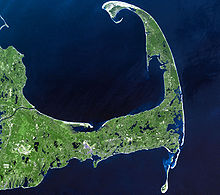Attack on Orleans
| Attack on Orleans | |||||||
|---|---|---|---|---|---|---|---|
| Part of the U-boat campaign of World War I | |||||||
 Imperial German Ensign and US media coverage of the Attack on Orleans | |||||||
| |||||||
| Belligerents | |||||||
|
|
| ||||||
| Commanders and leaders | |||||||
| Unknown |
| ||||||
| Strength | |||||||
|
Sea: Tugboat Perth Amboy Schooner Lansford 3 barges Air: 9 Curtiss HS seaplanes | Submarine U-156 | ||||||
| Casualties and losses | |||||||
|
Perth Amboy damaged Lansford and 3 barges sunk no casualties | None | ||||||
The attack on Orleans was a naval and air action during World War I on 21 July 1918 when a German submarine fired on a small convoy of barges led by a tugboat off Orleans, Massachusetts, on the eastern coast of the Cape Cod peninsula. Several shells fired during the engagement likely missed their intended maritime or aircraft targets and fell to earth in the area around Orleans, giving the impression of a deliberate attack on the town.[1]
Action
[edit]
On the morning of 21 July 1918, German submarine U-156, commanded by Kapitänleutnant Richard Feldt, was possibly attempting to cut the trans-Atlantic submarine communications cable from Orleans to Brest, France. While in the area for the buried cable, Feldt became aware of the passing tugboat Perth Amboy towing three barges and the three-masted schooner Lansford. It was claimed[by whom?] that U-156 fired two torpedoes; however, these were likely shells that missed their target or were warning shots across the Perth Amboy's bow. It is unlikely the U-156 would have wasted valuable torpedoes on a group of small unarmed ships.[citation needed] U-156 then appeared 3 miles (5 km) off Orleans and fired her two deck guns at the tug and her tow.[1] Perth Amboy was heavily damaged, and the schooner and three barges were sunk.[3][4]
Two Curtiss HS-2L flying boats from the recently completed Naval Air Station Chatham dropped bombs near U-156; but the bombs failed to explode due to technical problems or because the airmen on watch that Sunday were inexperienced at arming the bombs. U-156 elevated her guns to fire at the aircraft, but missed. Some shells landed harmlessly in a deserted marsh and on Nauset Beach, giving the town of Orleans the distinction of being the only spot in the United States that received enemy fire during World War I, but there is no evidence that these were deliberately aimed at the shore. There were no targets of value in the area other than the vessels. There were no fatalities.[1]
Nearby Station No. 40 of the United States Coast Guard launched a surfboat under heavy enemy shellfire and rowed out to rescue the 32 sailors trapped aboard the tug and barges. After firing 147 shells in the hour-long engagement, U-156 submerged about 11:30 a.m.[1]
A sign above the beach commemorates the engagement:
"Three miles offshore, in the direction of the arrow, was the scene of attack of a German submarine on a tug and barges July 21, 1918. Several shells struck the beach. This is the only section of the United States' coast shelled by the enemy during World War I."[5]
Aftermath
[edit]U-156 escaped and headed north, where she attacked other Allied ships. A few shells and craters were found on shore in Orleans and in the nearby marsh. Newspapers dubbed the engagement the "Battle of Orleans" and offered a reward for the discovery of submarine supply bases in the Bay of Fundy. The attack on Orleans was the only Central Powers attack on the contiguous United States during World War I. It was also the first time that the United States was shelled by artillery of an external power since the Siege of Fort Texas in 1846.[6]
Notes
[edit]- ^ a b c d e Biggers, W. Watts (1985). "The Germans are Coming! The Germans are Coming!". Proceedings. 111 (6). United States Naval Institute: 38–43.
- ^ Hodos, Paul (2017). The Kaiser's Lost Kreuzer: A History of U-156 and Germany's Long-Range Submarine Campaign Against North America, 1918 (1st ed.). Jefferson, North Carolina: McFarland Publishing. pp. 84–88. ISBN 978-1476671628. Retrieved 17 January 2021.
- ^ Neidell, Indiana "Indy" (16 June 2018). The Only German Submarine Attack On US Shore in WW1 I OUT OF THE ETHER. The Great War Series Channel – via YouTube.
- ^ Hodos, Paul (2017). The Kaiser's Lost Kreuzer: A History of U-156 and Germany's Long-Range Submarine Campaign Against North America, 1918 (1st ed.). Jefferson, North Carolina: McFarland Publishing. pp. 113–119. ISBN 978-1476671628. Retrieved 17 January 2021.
- ^ Klim 2014, p. Pg 2 of the Introduction.
- ^ Larzelere, Alex (2003). Coast Guard in World War One. Naval Institute Press, p. 135. ISBN 1-55750-476-8
References
[edit]- Klim, Jake (2014). Attack on Orleans: The World War I Submarine Raid on Cape Cod. Arcadia Publishing. ISBN 9781625850348. Retrieved 21 July 2020. - Total pages: 129
- Gibson, R.H.; Maurice Prendergast (2002). The German Submarine War 1914–1918. Periscope Publishing. ISBN 978-1-904381-08-2.
- Sheard, Bradley (1997). Lost Voyages: Two Centuries of Shipwrecks in the Approaches to New York. Aqua Quest Publications. ISBN 978-1-881652-17-5.
- Hodos, Paul (2017). The Kaiser's Lost Kreuzer: A History of U-156 and Germany's Long-Range Submarine Campaign Against North America, 1918 (1st ed.). Jefferson, North Carolina: McFarland Publishing. ISBN 978-1476671628. Retrieved 17 January 2021.
External links
[edit]- Helgason, Guðmundur. "WWI U-boats: U 156". German and Austrian U-boats of World War I - Kaiserliche Marine - Uboat.net.
- The U-Boat That Threatened America
- Conflicts in 1918
- 1918 in Massachusetts
- Atlantic operations of World War I
- Battles and conflicts without fatalities
- History of Barnstable County, Massachusetts
- Naval battles of World War I involving Germany
- Naval battles of World War I involving the United States
- Orleans, Massachusetts
- United States home front during World War I
- July 1918 events
